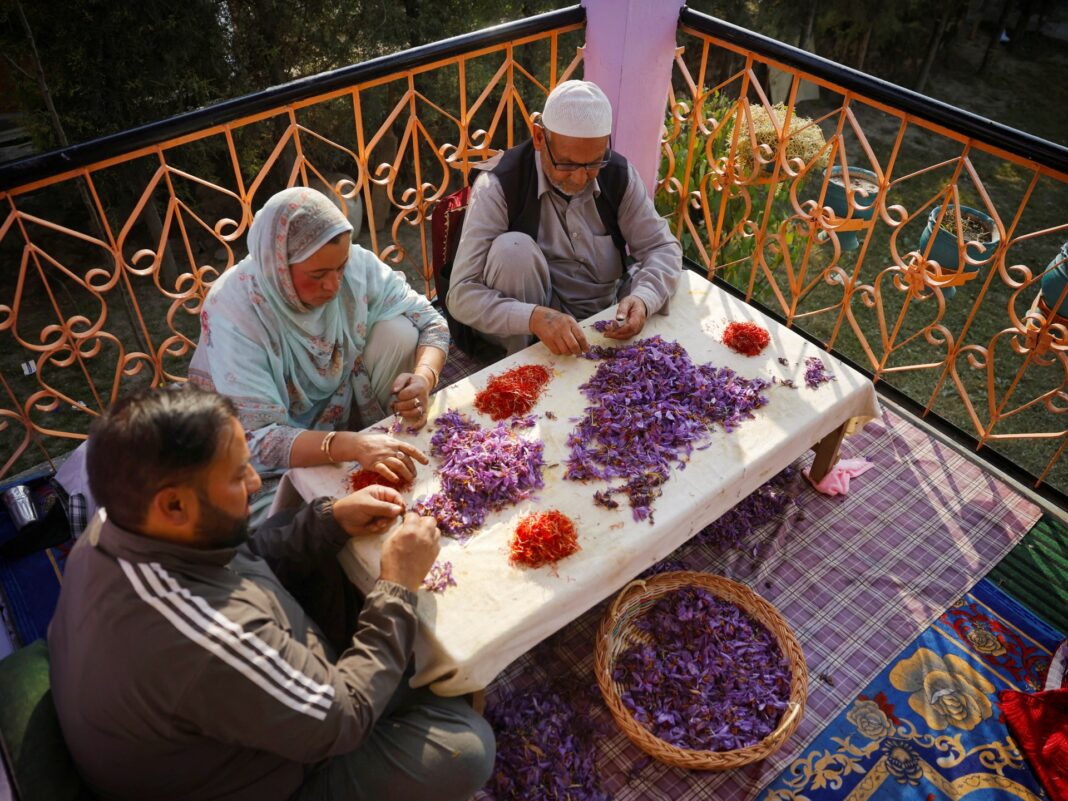Pampore, Indian-administered Kashmir – At 4am, before the first call to prayer echoes through Pampore’s saffron fields in the Pulwama district of Indian-administered Kashmir, 52-year-old Bashir Ahmad Bhat steps out with a flashlight.
The crisp air carries the scent of soil, but his heart sinks – his precious saffron corms, nurtured for months, lie ravaged, devoured overnight.
“It’s like a war,” Bashir says, his voice filled with exasperation. “We fought climate change, fought low market prices.”
“But who would have thought we’d have to fight porcupines?”
For generations, farmers like Bashir have cultivated saffron in Pampore, the heart of India’s saffron industry and the third-largest in the world after Iran and Afghanistan.
The land here is considered sacred by locals, producing some of the world’s finest saffron with an unmatched 8.72 percent crocin content. Crocin determines saffron’s colour and antioxidant value: the higher the value, the better the quality. Kashmir’s saffron has a deep crimson hue and strong aroma.
These farmers have faced a range of challenges and have outlasted them – from a more than three-decade-long deadly conflict between armed separatists and Indian security forces, to smuggling and adulteration of saffron as it heads to global markets, affecting prices for producers.
Yet, in recent years, the world’s most expensive spice faces a new and unexpected threat in Kashmir: the Indian crested porcupine.
A growing threat in the dark
Once confined to the region’s forests, the porcupines – a protected species in Jammu and Kashmir – have ventured into saffron farms, driven by deforestation, habitat loss and climate change. Unlike other rodents, these nocturnal creatures dig deep into the earth, seeking out saffron bulbs for food.
Kashmir’s saffron production was already struggling. Battered by erratic rainfall, inadequate irrigation and urban encroachment on farmland, it had plummeted from 15.97 metric tonnes in 1997-98 to just 3.48 metric tonnes in 2021-22.
But over the past five to seven years, farmers say the devastating damage wrought by porcupines has compounded the crisis. They report losing up to 30 percent of their crops annually to porcupines.
By 2024, federal government data showed Kashmir’s saffron yield had fallen to 2.6 metric tonnes, putting at risk a $45m industry that sustains 32,000 families across the region.
Ahmad estimates that he has lost at least 300,000 Indian rupees [$3,500] worth of saffron in the past two years due to porcupines. “At first, we thought it was stray animals. But when we started finding porcupine quills around the fields, we knew the problem was bigger.”

Failed solutions
The region’s forest department, recognising the growing infestation, attempted an organic repellent spray last year. Farmers hoped it would keep the porcupines at bay.
“It worked for a while, but they came back,” says 45-year-old Abdul Rashid, another farmer from the area. “They dig even deeper now, as if they have adapted.”
Some farmers have resorted to traditional methods: placing thorny bushes around their fields, setting up floodlights or even patrolling at night. None of it has worked. The porcupines are relentless.
“We need real action, not just words,” says Rashid, whose land borders Ahmad’s. “If this continues, Kashmiri saffron will disappear.”
The porcupine invasion is not just a local problem. Kashmir’s saffron is a global commodity, and any disruption in supply can send ripples through the international market, say industry insiders.
Iran’s saffron – which constitutes about 85 percent of the spice produced globally – has a lower crocin content (6.82 percent) than its Kashmiri cousin.
As Kashmir’s yields decline, traders fear Iranian dominance over the market will extend even further than it already does.
“If even 5 percent of the crop is lost to porcupines, that’s a 29-million-rupee ($350,000) loss annually,” says Bilal Ahmed, a saffron trader in Srinagar. “Prices will rise and Kashmiri saffron could become a luxury few can afford.”

The fate of Kashmir’s ‘red gold’
As dawn breaks over Pampore, Bashir Ahmad collects the scattered quills left behind by the porcupines. He sighs, knowing that tonight, the cycle will repeat.
For now, the battle continues. But farmers like Ahmad fear they’re losing and that the world may soon have to face a future without Kashmir’s prized “red gold”: An ounce of saffron in the global market costs more than an ounce of gold.
“If they keep coming, we will have nothing left,” he says, shaking his head. “This land has given us saffron for centuries. If we lose it, we lose a part of Kashmir itself.”
The porcupine invasion in Pampore’s saffron fields is no accident. Mir Muskan Un Nisa, a research scholar at the Sher-e-Kashmir University of Agricultural Sciences and Technology, says that habitat destruction and shrinking forest cover are making fewer food sources available in the nocturnal rodents’ native ecosystems. So, saffron corms provide an easily accessible and nutritious alternative.
“Their burrowing and feeding habits not only reduce saffron yields but also damage soil health, affecting future cultivation,” she says.
She explains that farmers must adopt protective measures like deep-set wire fencing, which extends 1.5 metres (5 feet) underground to make it harder for porcupines and other rodents to dig their way under them. Natural repellents, and motion-activated sensors that flash a light or make a sound when animals approach, thus scaring them, are other options, she says.
Devising techniques to safely trap the porcupines and relocate them “is crucial to safeguarding both the crops and the porcupine population”, she adds.
Climate change has played a significant role in Kashmir’s porcupine challenge, experts say. Erratic weather patterns have altered vegetation cycles, affecting the availability of porcupines’ traditional food sources. Warmer winters, which were once rare in Kashmir, now allow porcupines to remain active for longer periods, damaging saffron farms more than before.
Moreover, wild predators such as leopards and wild dogs helped maintain ecological balance by keeping porcupine numbers under control. However, with predator populations dwindling due to habitat destruction and human activity, porcupine numbers appear to have surged, say wildlife experts. They cite a sharp rise in sightings and crop damage, though there is no official census of porcupines.

What can be done?
Wildlife and agricultural experts are now exploring possible solutions to curb the porcupine menace.
“One suggestion is the controlled reintroduction of natural predators, such as wild dogs, to restore ecological balance. However, this remains controversial, as it could pose risks to livestock and human settlements,” says Zaheer Ahmad, a wildlife expert.
A more immediate solution that some farmers have attempted is fencing and trapping. While electric fencing has proven somewhat effective in deterring porcupines, it is prohibitively expensive for many small-scale farmers. Trapping and relocation of porcupines, if conducted systematically, could offer a viable alternative.
Scientists are also developing biodegradable repellents that mimic predator scents to scare away porcupines. Unlike the organic repellent spray tested last year, which yielded mixed results, these new formulations aim to provide a more lasting deterrent without harming the environment.
Safeguarding saffron crops is particularly challenging, says Intesar Suhail, the regional head of wildlife conservation and forest protection for North Kashmir.
“For fruit trees, like almond and apple, painting the trunks white or covering them with gunny bags can offer protection,” he tells Al Jazeera. White paint reflects sunlight, warding off pests, while gunny bags act as physical barriers.
But those tactics do not work for saffron, grown from bulbs in open fields, he says.
Planting specific species like wormwood or wild yam “around field perimeters may serve as a deterrent”, he says. These plants emit scents that porcupines avoid.
“Also, spraying pepper solutions around the bulbs could help, provided it does not harm the crop.”
However, saffron farmers say they need the government’s help to introduce these changes.
Compensation for crop losses, subsidies for fencing and long-term wildlife management policies could help mitigate the crisis, they say.
And time is running out.
“We used to worry about the weather or the market, but now, we are losing our crop before it even reaches harvest,” says Ghulam Nabi, a 39-year-old whose farm is next to Ahmad’s. “If this continues, our livelihood will be finished.”

